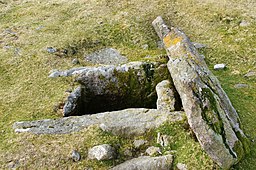Dartmoor kistvaens
| Dartmoor | |
| Protected Area | |
|
Kistvaen in Drizzlecombe on Dartmoor in South Devon, UK. The cap stone (which was originally used to seal the tomb) has been upended, and can be seen on the right of the image, behind the box-like structure of the cist.
|
|
| Country | United Kingdom |
|---|---|
| Part | England |
| County | Devon |
| Coordinates | 50°34′N 4°0′W / 50.567°N 4.000°WCoordinates: 50°34′N 4°0′W / 50.567°N 4.000°W |
| Highest point | High Willhays |
| - elevation | 621 m (2,037 ft) |
| Lowest point | Doghole Bridge |
| - elevation | 24 m (79 ft) |
| Area | 954 km2 (368 sq mi) |
| Animal | Dartmoor Pony |
| National Park of England | 1951 |
| Management | Dartmoor National Park Authority |
| - location | Bovey Tracey |
| Visitation | 10.98m |
| IUCN category | II - National Park |
|
Website: www |
|
Dartmoor kistvaens are burial tombs or cists from the late Neolithic and early Bronze Age, i.e. from c 2500 BC to c 1500 BC.Kistvaens have been found in many places, including Dartmoor, a 954 km2 (368 square miles) area of moorland in south Devon, England. The box-like stone tombs were created when the ancient people of the area lived in hut circles. Cists are often to be found in the centre of a cairn circle although some appear solitary which could be the result of the loss of an original slight mound. There are over 180 known cists on Dartmoor although there could be up to 100 that remain buried underneath unexplored cairns. In the South West there are no cists to be found on the Quantock Hills, only 2 to be found on Exmoor and 58 to be found on Bodmin Moor. The Dartmoor cists are unique in that about 94% have the longer axis of the tomb oriented in a NW/SE direction It appears that Dartmoor cists were positioned in such a way that the deceased were facing the sun.
In August 2011 an untouched cist, on Whitehorse Hill, near Chagford, was the first to be excavated on the moor for over 100 years.
The word "kistvaen" is derived from the Cornu-Celtic Cist-veyn or Cist-vyin; in Welsh the word is Cist-faen. All these names mean "a stone chest" (cist is a chest or box, maen is a stone). Kistvaens are formed using four or more flat stones for the sides and for the ends, and a larger flat stone (the "capstone") for the cover. Some kistvaens are surrounded by circles of erected stones. In general, if a body was to be buried without cremation, it was placed into a kistvaen in a contracted position. If on the other hand a body was cremated, the ashes were usually put in a cinerary urn, and then the urn was placed in a kistvaen.
However, the majority of the known Dartmoor kistvaens were opened at some time in the past, and whatever they used to hold is missing. The cists were probably robbed in the hope of finding treasure. Kistvaens were known by many common names, including "money pits", "money boxes", "crocks of gold", "caves", "Roman graves" and so on. The idea that ancient tombs might contain valuable items is a very old one; one of the first mentions of searching tumuli in Devon dates back to 1324. Permission to search was granted by Edward II of England.
...
Wikipedia


